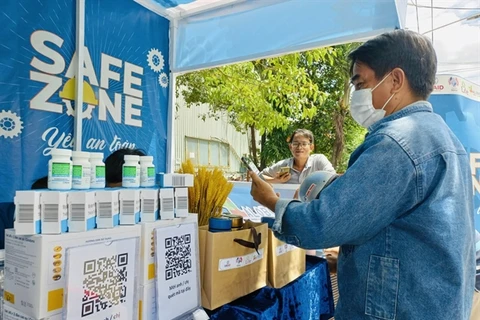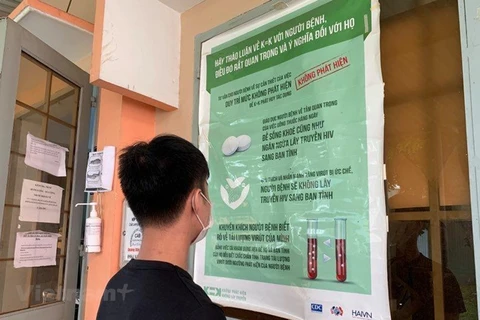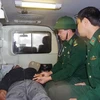Hanoi (VNA) – Among HIV/AIDS prevention and control measures for the time ahead, Hanoi in particular and Vietnam in general should offer more anti-HIV services so that they can access more groups in the community.
So said Arika Placella, member of the Board of the Global Fund to Fight AIDS, Tuberculosis and Malaria, while joining other delegates to the Global Fund Board’s 49th meeting during a visit to the health centre of Nam Tu Liem district in Hanoi on May 12.
She recommended that medical establishments should improve and diversify the services on HIV/AIDS prevention and control they supply.
The Nam Tu Liem health centre has reportedly obtained fruitful results in the work, especially the integration of anti-HIV services with those in preventing and controlling other diseases such as tuberculosis and Hepatitis B/C.
 The working session between delegates to the Global Fund Board’s 49th meeting and the health centre of Nam Tu Liem district (Photo: VietnamPlus)
The working session between delegates to the Global Fund Board’s 49th meeting and the health centre of Nam Tu Liem district (Photo: VietnamPlus) Placella spoke highly of the centre’s attainments in the provision of antiretroviral (ARV) therapy. In particular, all patients have been under viral load monitoring. Among them, 97% have been tested within the past 12 months, and the HIV viral suppression rate reaches 99.5%.
Doctor Nguyen Thu Trang, Director of the Nam Tu Liem health centre, said the station has supplied the ARV therapy using medicine provided by the Global Fund project since 2006. It is giving the therapy to 1,712 patients at present, comprising 1,695 adults and 17 children.
Among the HIV patients, 94% have been screened and got treatment for concurrent diseases such as Hepatitis B/C and non-communicable ones. All have received mental health screening and interventions, and 100% helped to move to higher-level medical establishments when necessary, she noted.
The health centre of Nam Tu Liem district was also the first medical facility in Hanoi to provide HIV/AIDS treatment and the preventive treatment using pre-exposure prophylaxis (PrEP). It is providing PrEP for 1,039 cases. Over the past years, it has established itself as a bright example of supplying ARV and PrEP therapies, helping reduce the rate of mother-to-child transmission in Hanoi, Trang added.
To bring down the number of new HIV infections and AIDS-related deaths, put an end to AIDS as an epidemic in Hanoi by 2030, and minimise impacts of the HIV/AIDS epidemic on socio-economic development, the municipal People’s Committee has built an action plan that includes implementation measures.
For 2023, the city targets that 90% of all people living with HIV will know their HIV status, 90% of all people living with HIV will have access to ARV therapy, and 98% of all people on ARV therapy will have suppressed viral loads.
 Delegates to the 49th meeting of the Board of the Global Fund visit the health centre of Nam Tu Liem district. (Photo: VietnamPlus)
Delegates to the 49th meeting of the Board of the Global Fund visit the health centre of Nam Tu Liem district. (Photo: VietnamPlus) The Global Fund is among the international organisations substantially assisting Vietnam with the prevention and control of AIDS, tuberculosis, and malaria.
Vietnam has received assistance from the Global Fund since 2003. So far, the fund has supplied over 650 million USD in non-refundable aid for the fight against HIV/AIDS, tuberculosis and malaria in the country.
Thanks to the support, the HIV/AIDS prevention and control programme has provided HIV preventive measures for nearly 1 million people and saved nearly 200,000 from death from AIDS.
Vietnam detected the first HIV case in 1990. 2023 is the 15th consecutive year HIV/AIDS has been put under control and declined in terms of all the three criteria: the number of new HIV infections detected, the number of people reaching the stage of AIDS, and the number of AIDS-related deaths./.

























